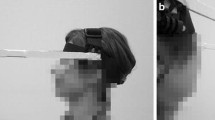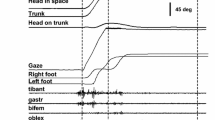Abstract.
Body, head, and eye movements were measured in five subjects during straight walking and while turning corners. The purpose was to determine how well the head and eyes followed the linear trajectory of the body in space and whether head orientation followed changes in the gravito-inertial acceleration vector (GIA). Head and body movements were measured with a video-based motion analysis system and horizontal, vertical, and torsional eye movements with video-oculography. During straight walking, there was lateral body motion at the stride frequency, which was at half the frequency of stepping. The GIA oscillated about the direction of heading, according to the acceleration and deceleration associated with heel strike and toe flexion, and the body yawed in concert with stepping. Despite the linear and rotatory motions of the head and body, the head pointed along the forward motion of the body during straight walking. The head pitch/roll component appeared to compensate for vertical and horizontal acceleration of the head rather than orienting to the tilt of the GIA or anticipating it. When turning corners, subjects walked on a 50-cm radius over two steps or on a 200-cm radius in five to seven steps. Maximum centripetal accelerations in sharp turns were ca.0.4 g, which tilted the GIA ca.21° with regard to the heading. This was anticipated by a roll tilt of the head of up to 8°. The eyes rolled 1–1.5° and moved down into the direction of linear acceleration during the tilts of the GIA. Yaw head deviations moved smoothly through the turn, anticipating the shift in lateral body trajectory by as much as 25°. The trunk did not anticipate the change in trajectory. Thus, in contrast to straight walking, the tilt axes of the head and the GIA tended to align during turns. Gaze was stable in space during the slow phases and jumped forward in saccades along the trajectory, leading it by larger angles when the angular velocity of turning was greater. The anticipatory roll head movements during turning are likely to be utilized to overcome inertial forces that would destabilize balance during turning. The data show that compensatory eye, head, and body movements stabilize gaze during straight walking, while orienting mechanisms direct the eyes, head, and body to tilts of the GIA in space during turning.
Similar content being viewed by others
Author information
Authors and Affiliations
Additional information
Electronic Publication
Rights and permissions
About this article
Cite this article
Imai, T., Moore, S., Raphan, T. et al. Interaction of the body, head, and eyes during walking and turning. Exp Brain Res 136, 1–18 (2001). https://doi.org/10.1007/s002210000533
Received:
Accepted:
Issue Date:
DOI: https://doi.org/10.1007/s002210000533




